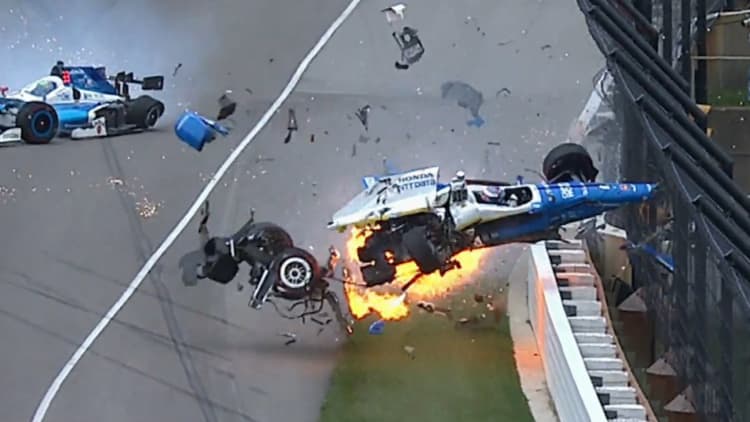On this week's episode of CNBC's "Jay Leno's Garage," four time IndyCar world champion Scott Dixon talks to Jay about his violent accident last May at the Indianapolis 500. When another driver lost control of his car and veered across the track into Dixon's path, Dixon's car went airborne, ricocheting off the track wall and spinning back onto the course upside down.
Dixon emerged from the wreckage unscathed and returned to competition a week later.
"You have bad memories where you've spun out or hit the wall or maybe had a big crash," Dixon tells Leno, "and those still linger in the back of your mind."
But what the greatest drivers do, he says, is block those memories out. "They think about just positive things. It's a trick of the trade, and some people do it a little better than others."
Accidents are not uncommon in IndyCar racing. In fact, the Indianapolis 500 is considered one of one of the most dangerous racing events in the world. As cars approach 240 mph speeds in their lightweight frames, the slightest contact with another driver can set them soaring.
Recent IndyCar models are designed to shred parts in the event of a crash and deflect energy away from the driver. But excess debris poses a threat to racers coming up behind an accident.
In addition to the potential for disaster, drivers also have to endure physical discomfort. "Normally, these aren't built for the buttockly challenged," Leno jokes when it is his turn behind the wheel. "I literally can't move an inch."
Being in shape is vital to last in a three-hour race, but, according to Dixon, what's more important is being able to ignore the discomfort. "If your arm is sore, if your legs are tired, and all you're doing is thinking about how bad your body is, you can't make these decisions quick enough."
IndyCar racers are not the only ones using these mental tricks. They're useful in other sports, too. Graham Betchart, a sports psychologist who has worked with some of the NBA's biggest stars, including three of the past four No. 1 draft picks, believes mindfulness training is what sets the greats apart.
"Having a fear-based life just drains energy," he tells CNBC. There is no reason to obsess over what can't be controlled. "This is how we empower players to score buckets in the NBA. You don't worry about the shots you've missed. You worry about getting present, trusting your skills, and moving onto the next play."
Betchart wouldn't be surprised to hear his philosophies endorsed by Dixon. In addition to NBA players, he's worked with UFC fighters, NFL and MLB players, and he is now bringing his philosophy to the business world with his company, Lucid.
Even Leno buys into it. In this week's episode, he has a slow, uncomfortable start on the raceway. But after getting his bearings, he's more at ease. He gradually picks up speed and describes "think[ing] his way around corners." He's having so much fun that, despite the risk, he doesn't want to stop.
When he hits 151 mph, Dixon says, "All right, I think you're done, man."
"What's that?" Leno responds through his headset in a deadpan voice. "I can't hear you."
CNBC's "Jay Leno's Garage" airs Wednesdays at 10 p.m. ET.



